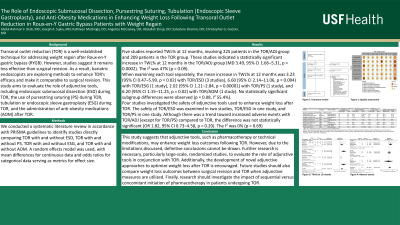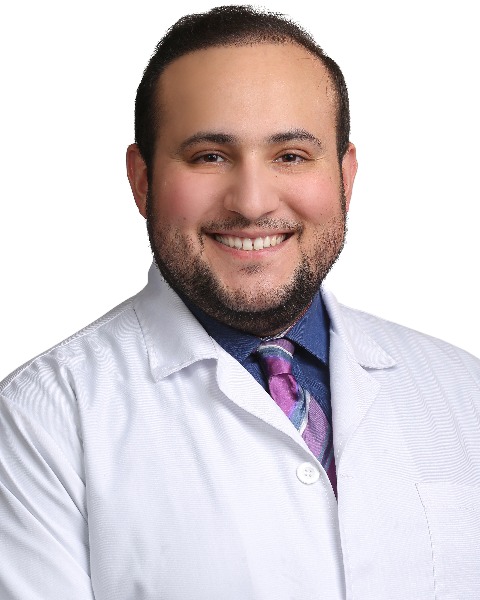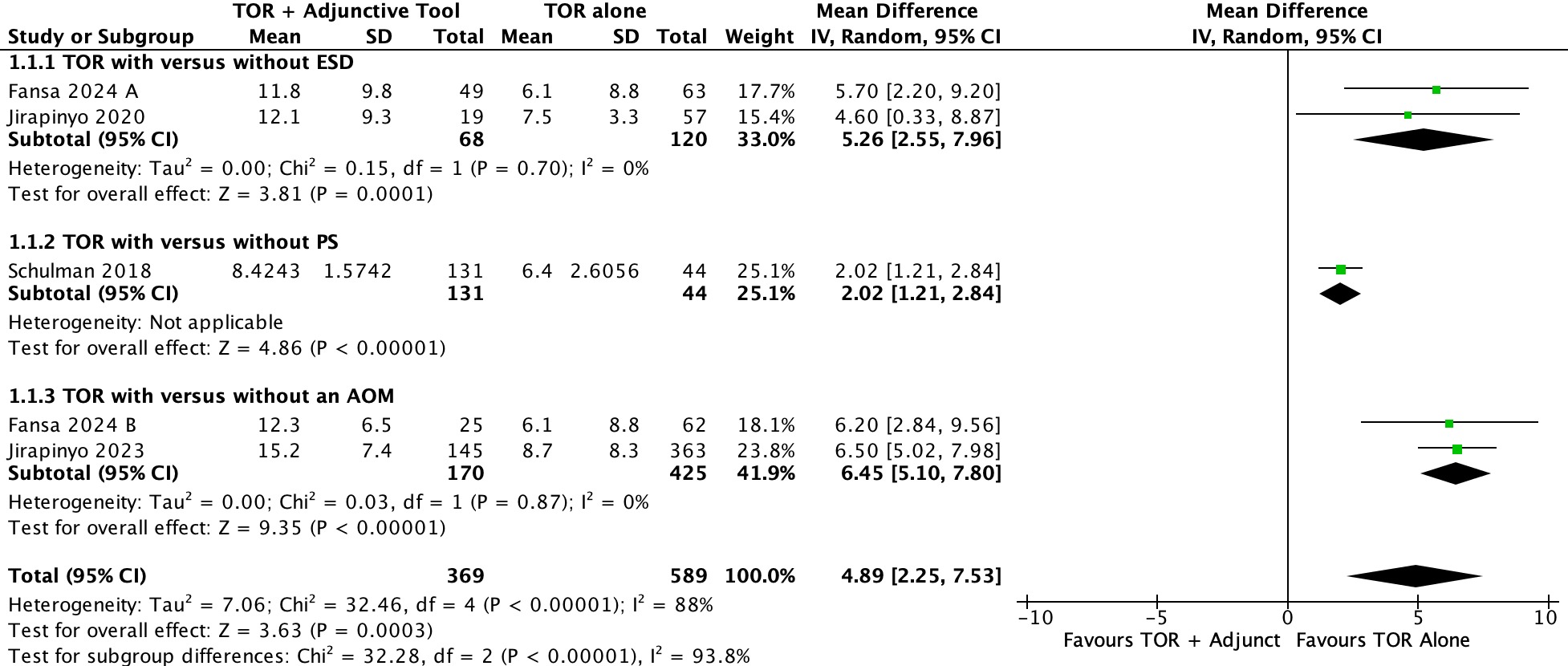Sunday Poster Session
Category: Interventional Endoscopy
P1032 - The Role of Endoscopic Submucosal Dissection, Pursestring Suturing, and Anti-Obesity Medications in Enhancing Weight Loss After Transoral Outlet Reduction in Roux-en-Y Gastric Bypass Patients With Weight Regain
Sunday, October 27, 2024
3:30 PM - 7:00 PM ET
Location: Exhibit Hall E

Has Audio

Abdul-Rahman F. Diab, MD
University of South Florida Morsani College of Medicine and University of Central Florida, HCA Healthcare GME
Ocala, FL
Presenting Author(s)
Abdul-Rahman F. Diab, MD1, Joseph A. Sujka, MD2, Kathleen Mattingly, DO3, Angelica McCaskey, DO3, Abdullah Elnaji, DO3, Salvatore Docimo, DO2, Christopher G. DuCoin, MD2
1University of South Florida Morsani College of Medicine and University of Central Florida, HCA Healthcare GME, Ocala, FL; 2University of South Florida Morsani College of Medicine, Tampa, FL; 3University of Central Florida, HCA Healthcare GME, Ocala, FL
Introduction: Transoral outlet reduction (TOR) is a well-established method for treating weight regain after Roux-en-Y gastric bypass (RYGB). However, studies suggest that it remains less efficacious than surgical revision. Consequently, bariatric endoscopists are investigating ways to enhance its efficacy to make it comparable to surgical revision. The aim of this study is to evaluate the role of adjunctive tools such as endoscopic submucosal dissection (ESD) during TOR, the utilization of pursestring suturing (PS) during TOR, and the use of an anti-obesity medication (AOM) after TOR.
Methods: We conducted a systematic literature review following PRISMA guidelines to identify articles directly comparing TOR with and without ESD, TOR with and without PS, and TOR with and without an AOM. We utilized the random effects model and employed mean differences for continuous data as metrics for effect size.
Results: Two studies compared TOR with and without ESD, one study compared TOR with and without PS, and two studies compared TOR with and without an AOM. All these studies reported total weight loss percentage (TWL%) at one year, with 369 patients in the TOR plus adjunctive tool group and 589 in the TOR alone group. A statistically significant increase in TWL% at one year was observed in the TOR plus adjunctive tool group compared to the TOR alone group (MD 4.89, 95% CI 2.25–7.53, p = 0.0003), I² = 88% (p < 0.00001). Subgroup analysis according to the adjunctive tool (ESD, PS, and AOM) revealed statistically significant subgroup differences (p < 0.00001, I² = 93.8%). The mean difference in TWL% at one year was 5.26, 2.02, and 6.45 when the adjunctive tool was ESD, PS, and AOM, respectively.
Discussion: This study suggests that weight loss after TOR can be augmented with various adjunctive tools. Multicenter randomized controlled trials with larger sample sizes are needed to confirm these findings. Additionally, while this study indicates that each adjunctive tool can successfully augment weight loss, the degree of augmentation may differ among these tools, as suggested by the subgroup analysis. Therefore, comparing different adjunctive tools is also a worthwhile avenue for further research. Most importantly, comparing TOR plus one or more adjunctive tools versus surgical revision is of paramount importance.

Disclosures:
Abdul-Rahman F. Diab, MD1, Joseph A. Sujka, MD2, Kathleen Mattingly, DO3, Angelica McCaskey, DO3, Abdullah Elnaji, DO3, Salvatore Docimo, DO2, Christopher G. DuCoin, MD2. P1032 - The Role of Endoscopic Submucosal Dissection, Pursestring Suturing, and Anti-Obesity Medications in Enhancing Weight Loss After Transoral Outlet Reduction in Roux-en-Y Gastric Bypass Patients With Weight Regain, ACG 2024 Annual Scientific Meeting Abstracts. Philadelphia, PA: American College of Gastroenterology.
1University of South Florida Morsani College of Medicine and University of Central Florida, HCA Healthcare GME, Ocala, FL; 2University of South Florida Morsani College of Medicine, Tampa, FL; 3University of Central Florida, HCA Healthcare GME, Ocala, FL
Introduction: Transoral outlet reduction (TOR) is a well-established method for treating weight regain after Roux-en-Y gastric bypass (RYGB). However, studies suggest that it remains less efficacious than surgical revision. Consequently, bariatric endoscopists are investigating ways to enhance its efficacy to make it comparable to surgical revision. The aim of this study is to evaluate the role of adjunctive tools such as endoscopic submucosal dissection (ESD) during TOR, the utilization of pursestring suturing (PS) during TOR, and the use of an anti-obesity medication (AOM) after TOR.
Methods: We conducted a systematic literature review following PRISMA guidelines to identify articles directly comparing TOR with and without ESD, TOR with and without PS, and TOR with and without an AOM. We utilized the random effects model and employed mean differences for continuous data as metrics for effect size.
Results: Two studies compared TOR with and without ESD, one study compared TOR with and without PS, and two studies compared TOR with and without an AOM. All these studies reported total weight loss percentage (TWL%) at one year, with 369 patients in the TOR plus adjunctive tool group and 589 in the TOR alone group. A statistically significant increase in TWL% at one year was observed in the TOR plus adjunctive tool group compared to the TOR alone group (MD 4.89, 95% CI 2.25–7.53, p = 0.0003), I² = 88% (p < 0.00001). Subgroup analysis according to the adjunctive tool (ESD, PS, and AOM) revealed statistically significant subgroup differences (p < 0.00001, I² = 93.8%). The mean difference in TWL% at one year was 5.26, 2.02, and 6.45 when the adjunctive tool was ESD, PS, and AOM, respectively.
Discussion: This study suggests that weight loss after TOR can be augmented with various adjunctive tools. Multicenter randomized controlled trials with larger sample sizes are needed to confirm these findings. Additionally, while this study indicates that each adjunctive tool can successfully augment weight loss, the degree of augmentation may differ among these tools, as suggested by the subgroup analysis. Therefore, comparing different adjunctive tools is also a worthwhile avenue for further research. Most importantly, comparing TOR plus one or more adjunctive tools versus surgical revision is of paramount importance.

Figure: Forest plot comparing transoral outlet reduction (TOR) with versus without an adjunctive tool in terms of total weight loss percentage at 1 year, with subgroup analysis according to the adjunctive tool used (endoscopic submucosal dissection [ESD], pursestring suturing [PS], and anti-obesity medication [AOM]).
Disclosures:
Abdul-Rahman Diab indicated no relevant financial relationships.
Joseph Sujka indicated no relevant financial relationships.
Kathleen Mattingly indicated no relevant financial relationships.
Angelica McCaskey indicated no relevant financial relationships.
Abdullah Elnaji indicated no relevant financial relationships.
Salvatore Docimo indicated no relevant financial relationships.
Christopher DuCoin indicated no relevant financial relationships.
Abdul-Rahman F. Diab, MD1, Joseph A. Sujka, MD2, Kathleen Mattingly, DO3, Angelica McCaskey, DO3, Abdullah Elnaji, DO3, Salvatore Docimo, DO2, Christopher G. DuCoin, MD2. P1032 - The Role of Endoscopic Submucosal Dissection, Pursestring Suturing, and Anti-Obesity Medications in Enhancing Weight Loss After Transoral Outlet Reduction in Roux-en-Y Gastric Bypass Patients With Weight Regain, ACG 2024 Annual Scientific Meeting Abstracts. Philadelphia, PA: American College of Gastroenterology.
